Field Notes: The Invisible Ink Symposium
In many ways, the In Visible Ink Symposium was quite conventional. A smiling volunteer hands you a lanyard and tote bag. The line for the cafe folds back on itself and waiting participants stare idly at their phones.
The initial, striking thing about the symposium is the venue. The WA Maritime Museum is cavernous, with ships suspended in mid-air like some Admiral’s Xanax-fuelled nightmare. The museum is a monument to Western imperialism and knowing — It is full of facts without context, like ships without water.
We’re ushered in to the main lecture theatre, where the day’s events are taking place. There is the familiar modern tension of bracing white fragility. We are here to hear stories of race and religion, those stories made marginal by our culture. We’re here to put to rest the kinds of zombie truths enshrined in Western museums, to attend our senses to the ghosts that haunt the monument we sit within.
There are lots and lots of white people with pads (guilty). They nervously click and unclick their pens (guilty). They are what Dolly Chugh calls “believers,” people who accept the reality of racial and cultural oppression. They are eager to learn how to navigate the fraught, choppy waters of racial politics. They want to become “builders,” people actively working to advance the position of marginalised people.
There are people of colour in the audience too, who seem a little more at ease. These aren’t things they haven’t heard before on Twitter or in the company of close friends. A museum, however, is maybe an unusual space to hear these conversations.
For two days we heard stories of refugees, indigenous Australians, activists and scientists who set about charting the waters of our racial politics.
There were no easy fixes, no solutions. When one questioner asked with exasperation, for the fourth or fifth time, What can we (read: privileged people) do to make things better?, indigenous elder Jim Morrison’s reply was warm yet brief: Be prepared for anger. Tones of trauma, healing and anger throughout the day served to continually calibrate the conversation from “white fixes,” to “non-white experiences.” Over time, the pens and pads gave way to the kinds of listening that can only be done by attentive eyes and ears.
The symposium was at its best when it did not shy away from the complexity and intersectionality of injustice. Deathscapes links Australia’s treatment of refugees and indigenous Australians under the broad banner of Settler Colonialism. Holocaust remembrance is used as a hedge against the return of ethnonationalism.
Tackling injustice requires the full employment of the head and the heart. Implicit is a tacit rejection of the professionalisation of social justice — creating a diverse and inclusive society is the work of culture.
I would’ve appreciated a fuller consideration of the role of technology in the maintenance and creation of injustice. Most speakers regarded technology as a mere tool of liberation, whether it’s using Virtual Reality or Social Media. This is one of the missing intersectionalities in a proper understanding of injustice. Technology is not a mere tool, it makes and shapes culture. Technology has provoked ethnic violence in Myanmar and commercialised racist software.
The In Visible Ink Symposium was the first by the new Museum of Freedom and Tolerance (WA), and it succeeded in bringing a genuinely diverse set of speakers and attendees together. The waters of our racial politics are no less choppy, but they are better charted, and we are perhaps all slightly better navigators as well.
